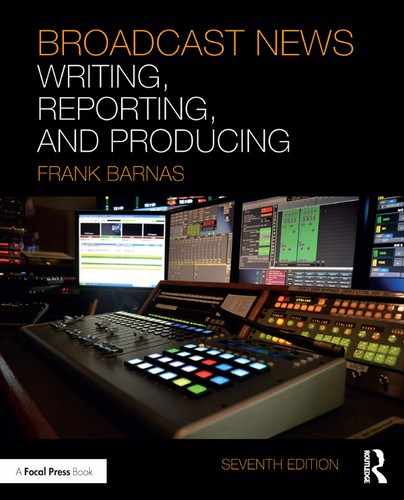This seventh edition of Broadcast News Writing, Reporting, and Producing is structured to guide broadcast journalism students through every facet of their chosen field. Each chapter begins with Key Words, a list that notes the important terms and definitions that will appear in the following pages. The text of each chapter contains practical advice and tips from industry professionals about that chapter’s subject matter. Finally, each chapter concludes with three segments: a Summary, which reviews the chapter’s main points; a Test Your Knowledge section, which offers questions relevant to the chapter; and Exercises, which allow students to apply the chapter’s themes with practical experience.
This edition also contains Fast Facts, which are brief historical and cultural references that illustrate the themes within the book. Web Links is a feature that shows students online resources that can be used to strengthen their journalism skills.
Part 1, Acquiring the News, contains chapters that cover the legal and ethical consideration of the news, how to find stories, develop sources, and collect information from both real and virtual documents. The section concludes with a chapter on the different types of stories and assignments that broadcast journalists will encounter.
Part 2 concentrates on Writing the News, the most fundamental skill a reporter must possess. In addition to detailing the mechanics of newswriting, there is in-depth analysis on both the style of newswriting and how a broadcast journalist can write effective leads.
Part 3, Reporting the News, expands from writing into merging video and audio into a news report. Topics in this part of the book include fieldwork, interviewing, covering planned events, and live reporting. The section ends with an in-depth look at the different types of story formats that appear on a typical newscast.
Part 4, Producing the News, examines how to assemble the day’s stories into a comprehensive newscast. Chapters deal with producing for both television and radio. For those who would like to deliver the news as reporters or anchors, a chapter on delivering the news provides on-air talent with professional advice on how to communicate with the audience effectively.
The text ends with two chapters (which together form Part 5 of the book) designed to help broadcast journalism students transition into the workforce. Chapter 17, Careers in Broadcast Journalism, offers insight into employment trends, data from the Bureau of Labor Statistics, and advice from media authorities on how to evolve from student to broadcast journalist. Chapter 18, Portfolio Development, is a new chapter that reveals how students can craft cover letters, resumes, sample reels, and websites that will help them in their job search.
Although the text is designed to be used linearly, journalism instructors and students are encouraged to use the chapters in whatever order works best for their individual programs.
